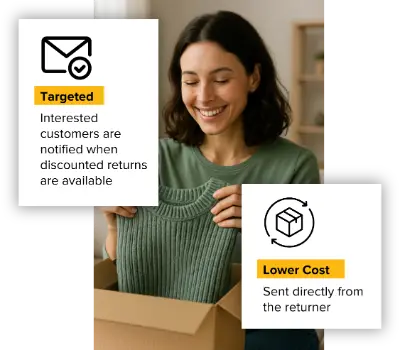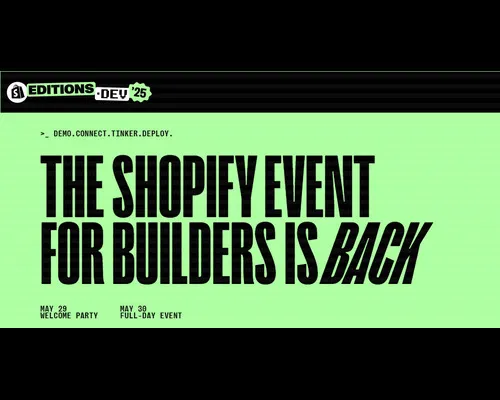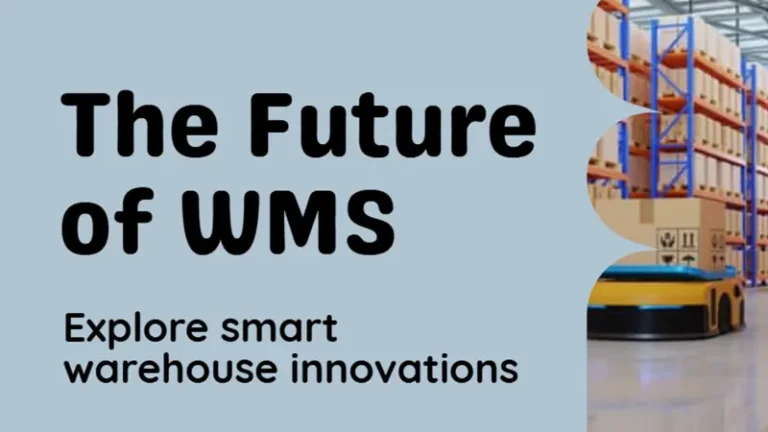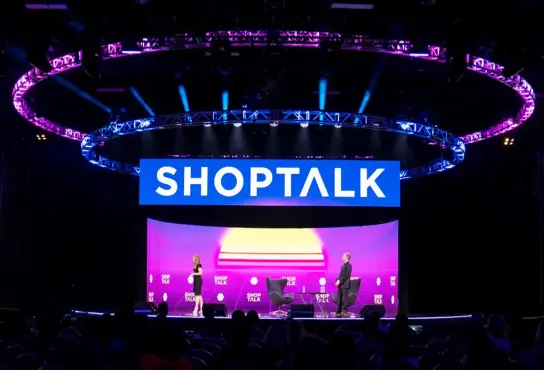Shopify Summit: Editions.dev
May 29-30, 2025 | Toronto, ON
Shopify’s exclusive ecosystem event is back in Toronto as part of Shopify Summit. Get hands-on with the latest Shopify tech and meet the product teams that make it happen.
Slash Your Fulfillment Costs by Up to 30%
Cut shipping expenses by 30% and boost profit with Cahoot's AI-optimized fulfillment services and modern tech —no overheads and no humans required!
I'm Interested in Saving Time and Money
Turn Returns Into New Revenue

Agentforce World Tour NYC
In this article
 1 minute
1 minute
November 20, 2024 | Javits Center | NYC
Experience the groundbreaking AI innovation of Agentforce, coming right to you from the main stage of Dreamforce. Dive into 135+ sessions, 25+ demos, and 10+ trainings to get hands-on and build customized Agents perfect for your business needs. It’s the biggest innovation from Dreamforce and for your business, live in NYC and all in one day.
Learn how AI agents are revolutionizing industries across NYC including financial services, healthcare and life sciences, media, public sector, and more.
Slash Your Fulfillment Costs by Up to 30%
Cut shipping expenses by 30% and boost profit with Cahoot's AI-optimized fulfillment services and modern tech —no overheads and no humans required!
I'm Interested in Saving Time and Money
Turn Returns Into New Revenue

Stripe Sessions: The Internet Economy Conference
May 6-8, 2025 | Moscone West | San Francisco, CA
Stripe Sessions brings together the payments and financial technology community to share ideas that drive progress.
Join us in San Francisco for talks on moving your business forward, opportunities to network with fellow leaders, and the first look at major upcoming product releases in the Stripe ecosystem—all designed to grow your revenue.
Slash Your Fulfillment Costs by Up to 30%
Cut shipping expenses by 30% and boost profit with Cahoot's AI-optimized fulfillment services and modern tech —no overheads and no humans required!
I'm Interested in Saving Time and Money
Turn Returns Into New Revenue

Ugly Talk: The Growth Blueprint
February 12, 2025 | New York, NY
This panel will explore the biggest surprises and defining moments of 2024, highlighting strategies that drove brand performance and lessons from missed opportunities. Looking ahead, experts will discuss shifting consumer trends, the blend of in-store and online shopping, and the future of influencer marketing.
The conversation will also examine the potential of AI tools like Shopify Magic and their role in product development and business growth. Finally, panelists will share insights on emerging design trends and investment strategies for 2025.
Slash Your Fulfillment Costs by Up to 30%
Cut shipping expenses by 30% and boost profit with Cahoot's AI-optimized fulfillment services and modern tech —no overheads and no humans required!
I'm Interested in Saving Time and Money
Turn Returns Into New Revenue

ONE Houlihan Lokey Global Conference
May 13-15, 2025 | New York Marriott Marquis, NYC
Houlihan Lokey is proud to announce the largest showcase of dynamic businesses through a series of multiday conferences in 2025.
These premier events will bring together the brightest minds in their industries and offer unmatched opportunities for networking, relationship building, and knowledge sharing.
Slash Your Fulfillment Costs by Up to 30%
Cut shipping expenses by 30% and boost profit with Cahoot's AI-optimized fulfillment services and modern tech —no overheads and no humans required!
I'm Interested in Saving Time and Money
Turn Returns Into New Revenue

10 Ways AI Agents are Transforming E-commerce Order and Inventory Management Systems
In this article
 100 minutes
100 minutes
Artificial Intelligence (AI) Agents represent a revolutionary leap in technological innovation and will transform business across every sector. They are intelligent systems that understand language and can perceive, analyze, and act upon complex data and/or workflows. “Act” is the key word. AI Agents take autonomous action on your behalf to complete the task or achieve the desired outcome.
The e-commerce industry stands to benefit enormously from this new technology because it’s a remarkably competitive and often low-margin business that unequivocally depends upon efficiency, accuracy, and adaptability for retailers and brands to be successful.
Slash Your Fulfillment Costs by Up to 30%
Cut shipping expenses by 30% and boost profit with Cahoot's AI-optimized fulfillment services and modern tech —no overheads and no humans required!
I'm Interested in Saving Time and MoneyUnlike conventional generative AI that generates outputs, (i.e. recommendations, and/or a plan), from “prompts” entered by a user (such as ChatGPT, Claude, etc.), AI agents self-reflect and learn from their interactions, continuously improving their performance without constant human intervention. AI agents can complete tasks that would normally require multiple tools and different activities, and you don’t need to be a developer to create and optimize them. For example, an AI agent (or agents, plural) could build and book a vacation within a given set of limitations. Think of all the steps (research and reviews, cross-references) that a human must perform to complete the same common task. The only thing to keep in mind is not to ask each agent to do too many different things. Keep each agent “in their lane” for optimal results.
- Always-On Customer Service
AI agents don’t sleep, take a lunch break, or have a bad day. While customer service may be the lowest-hanging fruit and most easily implemented on this list, AI agents are available when your customers need them, regardless of time zone, and they can answer most of your customer’s questions and resolve most of their issues. Most importantly, they can be configured to hand off to a human when they cannot resolve the inquiry or when the conversation otherwise reaches a point where the business may want to speak directly with the customer, such as discount or refund requests. But they can indeed be employed to create replacement orders, cancel subscriptions, and adjust auto-ship frequency, among other things. - Best-in-Class Demand Forecasting
Predict demand with remarkable accuracy to optimize procurement and avoid overstocking and stockouts. Traditional approaches are often plagued by unsophisticated data analysis methods leading to bad assumptions, and thus, poor procurement decisions. But modern Inventory Management Systems (IMSs) use AI agents to analyze massive amounts of historical sales data, read real-time news feeds to consider market trends and identify supply chain disruptions, track inventory movements, plus any number of other data points of interest, to make intelligent, real-time forecasts in the context of existing inventory available across internal and external fulfillment centers. - Autonomous [Humanless] Procurement
Building upon demand forecasting, AI agents can automatically create Purchase Orders with vendors at precisely the right time based on requirements such as minimum order quantity, and also based on defined guard rails such as total spend, current and future cash flow expectations, and vendor lead times for prep and transit. The best part is that it’s all based on natural language processing so if you can explain it, it can be done without complicated diagrams or wireframes. - Optimize Distributed Inventory Strategies
Minimize final mile shipping cost by staging inventory closer to your customers. Split inbounds across fulfillment centers based on the regional demand forecasting models described previously to optimize placement and minimize the cost of transferring inventory between locations later. Further, use the technology to track the inbounds and update ETAs for the team accordingly. Amazon’s been doing it for years. Now SMB retailers and brands can take advantage of the same technology. - Lowest Shipping Cost by Design
E-commerce retailers and brands traditionally have humans use their experience to ship orders, (primarily because legacy shipping software hasn’t innovated in over 10 years). But that approach is notoriously error-prone and costs the company a ton of money that should be kept as profit, even if it’s done at the manager level. Modern multi-carrier shipping software removes the human and creates the optimal shipping label that will deliver the order on time, every time. And now, combining that intelligence with AI agents, Order Management Systems (OMSs) can get even more granular and monitor weather conditions along shipping lanes, and then re-route orders to fulfillment centers that are more likely to deliver them by the promised delivery date, preventing customer service inquiries such as WISMO (Where Is My Order?) and refund requests. - Remove Waste from Fulfillment Workflows
Automate critical but rote tasks that would otherwise need to be completed by a human (e.g. creating shipping labels). Why does a human have to pick and click to print a label? Change your people from processors into analysts and put them on the tasks that will grow the business. - Supercharge Returns Programs
Returns are painful, but a necessary evil for any e-commerce operation. It’s critical to manage returns effectively (especially for the highest return rate categories such as women’s apparel). Groundbreaking new returns technologies such as the Cahoot Peer-to-Peer Returns Solution are already eliminating returns by enabling the return to be shipped directly to the next customer, saving significant money and time. Now add an AI agent that can predict the likelihood that the returned item will be sold in the next 7 days, and you’ve supercharged your returns program! - Optimize Warehouse Layouts
New technologies such as Synkrato’s Warehouse Optimization System (WOS) – powered by AI and Digital Twins are emerging to help merchants create a virtual warehouse that mimics their exact space, inventory positions, equipment storage, window and door positions, etc. which can be used to make changes in the virtual world and determine the impact of the change before going through all the work to find out that it wasn’t going to work. Optimize warehouse layouts, inventory storage, and more. - Dynamic Pricing Strategies
Unified commerce systems can leverage customer data including products viewed, dwell time, shopping cart contents, previously abandoned carts, purchase history, returns history, and demographic data in real time to create tailored shopping experiences that align with individual preferences. AI agents can monitor competitor pricing along with inventory levels and sell-through rates, read mass quantities of e-commerce news feeds to assess market demand and availability and make real-time pricing adjustments that convert the sale while maximizing profitability and remaining competitive. These personalized interactions not only drive sales but also foster loyalty. - Driving Business Insights with Advanced Analytics
Because AI agents can analyze enormous datasets quickly, and because most merchants have ‘dark data*’ that they don’t even know about, AI agents have access to many more insights and can identify many more trends than retailers can even think about asking for. At least currently. For example, Sellers can evaluate supplier performance at a micro-level comparing negotiated agreements and SLAs to actual performance and events and use the data to negotiate better terms.*Dark data refers to the unused portion of an organization’s information collected and stored during their regular business activities but fails to be used for analytics, advancing business relationships, or direct monetization. It’s not uncommon for as much as 50% of a company’s data to be dark.
Looking for a New 3PL? Start with this Free RFP Template
Cut weeks off your selection process. Avoid pitfalls. Get the only 3PL RFP checklist built for ecommerce brands, absolutely free.
Get My Free 3PL RFPSummary
The transformative potential of AI agents extends beyond mere automation rules and logic trees. AI agents are redefining how e-commerce businesses approach inventory and order management, transforming these processes from reactive tasks into strategic capabilities. By leveraging advanced technologies, these systems can dig deep into the dark data and deliver precise forecasting, intelligent automation, and actionable insights that enhance operational efficiency unlike ever before. They’re intentionally more specialized than generic generative AI such that the language that is used and the context that is understood within a particular industry or vertical, results in a more reliable and relatable assistant compared to the ChatGPTs and Claudes of the world.
As e-commerce businesses become more fluent in these new technologies and embrace these advancements, AI will transition from being a competitive advantage to a foundational necessity. Companies that integrate AI systems effectively will not only streamline their operations but also build the agility needed to thrive and position themselves for long-term success.

Turn Returns Into New Revenue

How AI Agents Will Make Webstores Vanish Forever
Online Stores (Webstores) Are About To Disappear Forever
Artificial Intelligence (AI) Agents are going to transform business across every sector, and e-commerce will be one of the industries that changes the most because every online shopper will have their own AI agent that fetches products, and brings the products to them, displaying the products and details in a format that they like, not that the retailer chooses for them. Any stores; all stores. So, there’s no real need for a store anymore. Product data feeds have existed for a long time. AI agents can ingest data feeds and serve the results in a clear and easy-to-understand display, designed by YOU. They can automatically filter the results, present the best options, and then place the orders.
Why should you have to start with a search, then browse an online catalog, read all the reviews (while having to determine which ones can be trusted), and click back and forth through styles across as many websites as you have the time to spend?
AI agents are intelligent systems that understand language and are able to perceive, analyze, and act upon complex data and/or workflows. “Act” is the key word. AI Agents take autonomous action on your behalf to complete the task or achieve the desired outcome. Need a pack of white undershirts? Feed the requirements into the agent using natural language and pick from the results that used YOUR search criteria, YOUR size, YOUR gender; not the results determined by Google or Amazon using algorithms and rankings nobody understands.
Slash Your Fulfillment Costs by Up to 30%
Cut shipping expenses by 30% and boost profit with Cahoot's AI-optimized fulfillment services and modern tech —no overheads and no humans required!
I'm Interested in Saving Time and MoneyNow that may be a provocative thought experiment, but it will happen, it’s only a matter of when. But, retailers and brands will always need an Order and Inventory Management System because there needs to be a central repository for all the master product catalog data, customer data, all the transactions such as orders, returns, and cancellations, the need to capture (or receive) payments, track inventory and keep channel listings up-to-date, the ability to analyze all the data from all the sales channels and make business decisions accordingly. So an OMS/IMS is the central nervous system for all the critical business data. And now these SaaS platforms are being supercharged with AI agents to perform tasks and generate insights with unprecedented speed and accuracy. Let’s take a look at some examples:
- Best-in-Class Inventory Management and Procurement
Modern Order and Inventory Management Systems (OMS/IMS) predict demand with remarkable accuracy by using AI agents to analyze tens of millions of data points from historical sales data, supply chain status, seasonality, market trends, and more, to make intelligent, real-time forecasts for demand. AI agents can then automatically create Purchase Orders with vendors taking into consideration things like minimum order quantity, vendor lead time, and estimated transit days including current port congestion forecasts. And the best part is that it’s all based on natural language processing so if you can explain it, an AI agent can do it. - Remove Waste from Fulfillment Workflows
Humans are typically responsible for fulfillment operations (pick, pack, and ship), but traditional workflows are notoriously error-prone and cost the company tens of thousands of dollars that could otherwise be saved by using modern AI-enabled shipping software which removes the human from all (bad) decision-making and creates the optimal pick tours in the warehouse and then creates the cheapest shipping label using the smallest box or mailer that will deliver the order safely and on time. - Optimize (or Better Yet, Eliminate) Reverse Logistics
AI agents can predict potential returns and optimize the reverse logistics process by identifying items likely to be returned and streamlining the return handling procedures and communications. Further, they can proactively notify Sellers and customers about the likelihood of a return before the order is shipped (which is critical for the highest return rate categories such as women’s apparel). Groundbreaking new returns technologies such as the Cahoot AI-enabled Peer-to-Peer Returns Solution are already eliminating returns by enabling the return to be shipped directly to the next customer, which is cheaper, faster, and better for the planet. By eliminating one leg of shipping, eliminating warehouse processing, the returned item is sold faster, and the econ-conscious program enhances brand reputation. - Drive Business Outcomes with Advanced Analytics
AI agents can analyze enormous amounts of data quickly, and all of it, not just the headline data points like sales and returns. AI can identify more trends and answer more questions than retailers can even think of asking. For example, AI agents can identify anomalies in sales patterns, inventory levels, or customer behavior, alerting businesses to potential issues and enabling timely intervention. Another example: Sellers can evaluate supplier performance at a micro-level comparing negotiated agreements and SLAs to actual performance and use the data to negotiate better terms on their behalf, all while humans are working on growing the business.
Looking for a New 3PL? Start with this Free RFP Template
Cut weeks off your selection process. Avoid pitfalls. Get the only 3PL RFP checklist built for ecommerce brands, absolutely free.
Get My Free 3PL RFPSummary
Online stores (webstores) may be about to disappear forever, but Order and Inventory Management Systems are getting the long-awaited boost that they needed. Artificial Intelligence (AI) agents are set to revolutionize e-commerce by acting autonomously to streamline workflows across inventory management, order fulfillment, and reverse logistics, among other things, and it’s the OMS/IMS that’s leveraging this new technology to do it. By integrating Order and Inventory Management functions with real-time/real-world news and events, AI agents predict demand with precision and automate procurement decisions and actions. By leveraging modern fulfillment and reverse logistics solutions to automate rote but essential work, workflows are optimized and errors and operational costs are reduced. Lastly, AI agents are capable of exceptionally sophisticated analysis of OMS/IMS data that helps to identify actionable insights from untapped corners of the database to drive unprecedented profitability and success.

Turn Returns Into New Revenue

The Lead Summit 2025
In this article
 1 minute
1 minute
May 28-29, 2025 | Pier 36, New York City
The Lead Summit brings together globally-recognized scaled brands, high-growth challenger brands, forward-looking retailers, and the next-gen tech enabling the future.
Across two dynamic days in vibrant NYC, you’ll make beneficial connections, learn & apply what’s working for other brands, and develop business-changing tech partnerships.
Slash Your Fulfillment Costs by Up to 30%
Cut shipping expenses by 30% and boost profit with Cahoot's AI-optimized fulfillment services and modern tech —no overheads and no humans required!
I'm Interested in Saving Time and Money
Turn Returns Into New Revenue

Shoptalk Spring
In this article
 1 minute
1 minute
March 24-27, 2025 | Mandalay Bay, Las Vegas
Shoptalk is the ultimate gathering of retail, where 10,000+ retail decision-makers converge to discover the future of retail. Get ready for three action-packed days that will expand your horizons and catapult your business forward.
Slash Your Fulfillment Costs by Up to 30%
Cut shipping expenses by 30% and boost profit with Cahoot's AI-optimized fulfillment services and modern tech —no overheads and no humans required!
I'm Interested in Saving Time and Money
Turn Returns Into New Revenue

Top Holiday 2024 Consumer Shopping Trends
The 2024 holiday shopping landscape presents a complex picture of consumer behavior marked by notable contrasts across different shopper demographics. Despite economic uncertainties, holiday spending is reaching record levels, with consumers prioritizing family gifts while adapting their shopping strategies to navigate financial pressures.
We’ve scoured the top 2024 Holiday Shopping Surveys and predictions and summarized the research to help retailers gain insights into consumer spending, purchase intentions, and buying behaviors.
Economic Considerations and Budget Management
Many consumers will start holiday shopping earlier than usual to spread their budget, avoid crowds, and take advantage of early promotions. Despite this early start, many shoppers still expect to complete their purchases in December.
Consumer spending patterns reveal a significant divide between different groups. While some shoppers are reducing their holiday expenditures due to economic concerns, others are substantially increasing spending, reflecting growing economic disparities in the market. To prioritize their holiday budgets, many consumers make trade-offs by cutting back on other expenses like dining out and entertainment.
Free shipping and discounts remain the strongest motivators for purchases, while retailers’ reliability in meeting date-certain shipping promises continues to impact consumer loyalty significantly. Despite economic pressures, consumers can still be enticed to make impulse purchases with the right incentives.
Role of Digital Channels
Digital channels dominate holiday shopping, with most consumers discovering deals through online sources, social media, and e-commerce sites. Black Friday and Cyber Monday maintain their appeal, and home delivery remains the preferred fulfillment method for online purchases. Still, alternatives like in-store pickup are gaining popularity, especially among younger generations.
Generation Z has emerged as a particularly influential force in holiday shopping, demonstrating distinct preferences and behaviors. Their approach is predominantly digital-first, embracing self-checkout technology, mobile payments, and branded apps. This generation is heavily influenced by social media and digital content, with celebrity and influencer endorsements significantly impacting purchase decisions. They’re also unique in allocating more of their budget to self-gifting than other generations.
Slash Your Fulfillment Costs by Up to 30%
Cut shipping expenses by 30% and boost profit with Cahoot's AI-optimized fulfillment services and modern tech —no overheads and no humans required!
I'm Interested in Saving Time and MoneyPhysical Stores and Technology Integration
Physical retail plays a vital role in holiday shopping, with frequent in-store shoppers typically spending more overall. Stores attract customers through holiday displays, seasonal atmosphere, and exclusive products. Retailers are responding by integrating more technology into their physical spaces, creating a hybrid shopping experience that combines traditional and digital elements.
Gender-Based Spending Patterns
Gender-based shopping patterns show interesting shifts, with male shoppers leading in spending, particularly in categories like footwear (for themselves), electronics, and video games. Men are also showing greater enthusiasm for holiday travel and tech-enhanced shopping experiences.
Popular Gift Choices
Key product categories driving holiday sales include toys and books, video games, electronics, and personal care items, with gift cards maintaining their position as the most requested item. However, there’s surprisingly low interest in AI-powered gadgets, though millennials show the most enthusiasm for these products.
Travel Trends
Travel remains a significant component of holiday plans, though there’s a trend toward staying with friends and family, especially among cost-conscious travelers and baby boomers. Those who travel during the holidays tend to be bigger spenders across all categories, including gifts and entertainment.
Multi-Channel Shopping Journey and Sustainability
The holiday shopping journey has become increasingly complex and multi-channeled. Consumers typically begin with in-store experiences and word-of-mouth for product discovery, then move to online channels for research and comparison shopping. Thus, brands and retailers must have superior technologies such as order management and inventory systems. Different generations show distinct preferences throughout this journey, with baby boomers favoring in-store shopping and prioritizing convenience. In contrast, younger generations embrace mobile apps and show more interest in sustainable shopping and experiential gifts. All consumer groups’ priorities have shifted notably toward sustainability, with many shoppers willing to choose slower delivery methods to reduce their carbon footprint. They prefer brands demonstrating environmental commitment, though price sensitivity remains critical in decision-making.
Looking for a New 3PL? Start with this Free RFP Template
Cut weeks off your selection process. Avoid pitfalls. Get the only 3PL RFP checklist built for ecommerce brands, absolutely free.
Get My Free 3PL RFPInfluence of Generative AI
Marketing strategies are evolving, with traditional promotional tools like email newsletters having less impact than direct discounts and shipping offers. Generative AI is emerging as a valuable tool in enhancing the shopping experience, particularly among younger generations who find AI-driven recommendations helpful for making purchase decisions.
Summary
For retailers and marketers, the 2024 holiday season presents opportunities and challenges. Success depends on offering value, personalization, and memorable experiences across physical and digital channels while remaining sensitive to economic pressures affecting many consumers. The emphasis on tech integration, the growing importance of omnichannel experiences, and the increasing influence of younger generations will likely continue shaping retail behavior and customer loyalty. For brands that can successfully balance innovation with tradition while meeting diverse consumer needs and master ecommerce order fulfillment, this holiday season promises to be successful despite economic uncertainties.

Turn Returns Into New Revenue















